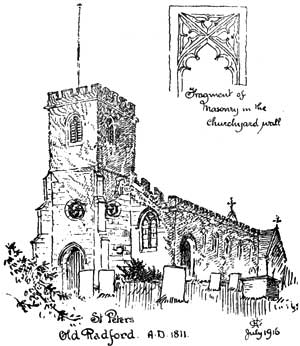ST. PETER’S, RADFORD.
 St Peter's, Old Radford. Inset shows fragment
of masonry in the churchyard wall.
St Peter's, Old Radford. Inset shows fragment
of masonry in the churchyard wall.The church of St. Peter at Old Radford stands in a “toft” or meadow which slopes gently down to the left bank of the Leen. The “town” of Radford, now incorporated with the City of Nottingham, is a busy hive of industry, and the church wears a very modern aspect, no part of the present fabric dating back more than a century. From the notes made by Stretton, prior to its demolition, we learn that the old church comprised a nave, and south-aisle, separated by a pier-arcade of two pointed arches carried on cylindrical columns, and a low tower steeple of Norman architecture, while the chancel was of the “lancet” period.
All that remains visible of the old church is a few fragments of worked stone, built into the boundary walls of the churchyard, or scattered about in the gardens around, and two old bells which are re-hung in the tower. One of these bells bears the well known mark of George Oldfield (a Calvary with crescent and star and the initials G.O.); the names of the churchwardens (T. Tayler, T. Rial Wardens) and the date 1661. The other is probably much older; it bears the word GABRIEL, in Lombardic capitals, and the mark of an unknown founder (within a shield, a cross patee or Maltese cross). This was doubtless the Angelus bell of pre-Reformation use, which was rung early in the morning and at night when every Christian person was wont to say the words of St. Gabriel: “Ave Maria gratia plena benedicta tu in mulieribus et benedictus fructus ventris tui.”
It seems highly probable that, like other churches on the Leen, the old church was repaired and partially re-built at the beginning of the 13th century under the influence of that “strenuous advocate for the erection of Chapels” Archbishop Walter de Gray (1215-1255) of whom it was said “cautious and wise as a Statesman, pious and munificent as a Prelate, he found the province to which he was translated a barren wilderness, he left it a fruitful garden.” At any rate the first vicar of whom we have any record is “Master Ralf the clerk,” who was admitted on the 12th Kal. March, 1224, by Walter Gray, Archbishop of York, “he being then at Lenton.”
The presentation was made 18th February, 1224, by the Prior and Convent of Lenton, to whom William Peverel had given “the town and church of Radford.” In their gift it remained until the Suppression when it came to the Crown.
The Vicar of Radford is again mentioned in connection with a chantry of Our Lady, founded by John le Colier in 1340, in the church of Sutton Passeys—a village which stood somewhere between Radford and Wollaton until it was devastated by the “Black Death” pestilence in 1349. The church and the village of Sutton Passeys has now passed out of all recollection. As long ago as 1667, Thoroton stated “it is now, and long hath been totally decayed and only known by the name of Wollaton Park.” (p. 220). The chantry was removed into Wollaton Church in 1360.
In the early days there would seem to have been no family monuments of note, nor any chantry endowments at Radford. Very shortly before the Reformation, a bequest was made by Robert England, which is thus entered in Chantry Certificates:—
13. The parishe churche of Radforthe.
Ys Worthe by yere in a certaine somme of money granted for terme of certayne yeres, to be payed by thexecutours of the laste will and Testament of Robert Inglande for the Contynewaunce of a Trentall of masses to be song there vntill the furste Daie of Maye that shalbe in yere of our lorde god m’dlvj.
Xs for terme of years.
At the beginning of the 19th century church building was again active in Nottingham.
Sneinton Church was re-built and opened on October 28th, 1810; Christ Church, New Radford, was built and opened September 13th, 1812; St. Peter’s, Old Radford, was pulled down and rebuilt (so far as nave, aisles and tower are concerned) in 1811-1812,
The chancel, although in a ruinous and encumbered state, was not included in the building scheme; the present chancel and vestry were added in 1871.
Registers commence, 1563.
